The Apple TV is a great little device on which to watch movies, listen to music, view your photo collection and share content that you have on your Mac, as well as being a second screen for all your iOS devices (and Mac) – all at the touch of a button using AirPlay.
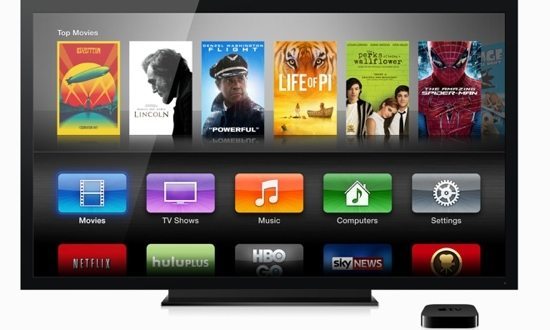
Apple’s “hobby” project has a simple yet effective and easy to use interface, access to a massive library of content through iTunes, and is one of the best streaming set top boxes available today especially if you have Apple kit already. Hopefully one day Apple will also add the ability to play games and apps…
Of course, the Apple TV isn’t the only such streaming video device on the market. But what else is there? In this post, we describe some of the alternatives as well as their pros and cons. Of course, the right device for you really depends on what you want – such as the ability to stream content from your iPad or other tablet. Or maybe you have an existing library of content in multiple formats that you want to watch, plus the ability to play content from an SD card or external hard disk, and many more factors besides.
For watching videos only, popular Internet-based streaming services such as Netflix and Hulu Plus may fit the bill, but this article describes hardware-only set-top boxes that you can plug into your HDTV, as these allow a far richer user experience and often the ability to connect to your smartphone or tablet. Moreover, some of these devices also offer built-in access to Netflix and other popular streaming services like YouTube.
Read on to find out more…
Roku 3
Price: around £130 (from Amazon UK)
Roku has established itself as quite a popular device for streaming content to your HDTV. The previous generation model lacked a decent interface and was somewhat sluggish, but the latest version has a much more powerful processor and a redefined interface that’s a cinch to use, as well as by far the widest selection of channels of all the devices list here. Another nice touch is the remote control, which has a built-in headphone jack – useful when you want to watch in private.
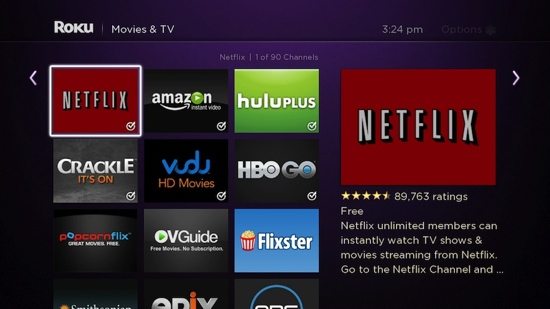
Unfortunately, you can’t use Apple’s AirPlay out of the box with the Roku 3, but there’s a free application called Twonky Beam which will let you beam content from your iOS devices (or Android) to the TV via Roku. Additionally, the universal search feature is simply brilliant – you just type in the name of a movie, show or even an actor and you’ll see instant results across all channels, and it’ll tell you whether it’s going to be free or how much it will cost.
Some of the best channels in the lineup include Amazon, Vudu, Netflix, Hulu, TimeWarner, HBO Go, Disney, and hundreds more.
Supported multimedia formats include MP4 (H.264) video, MKV (H.264) video, AAC audio, MP3 video, and JPG and PNG images. This isn’t as many as some of the devices listed here, however (such as the WDTV Play).
It’s also worth noting that if you’re on a budget, you can pick up some of the older model Roku’s for much less cash.
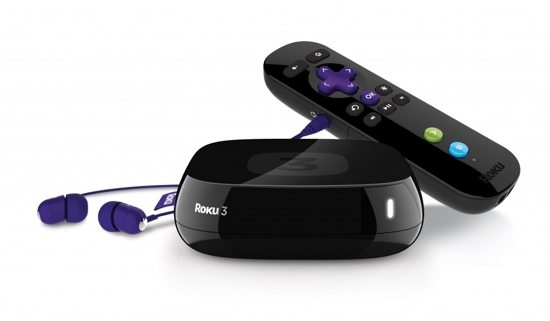
Pros:
- Has the largest choice of video streaming applications (more than 750 channels) and can play games.
- USB port and MicroSD card slot
- Choice of file types for playback is limited
- Great UI and navigation between channels is easy
- Universal search feature
Cons:
- Lacks a few popular video services such as Hulu Plus and YouTube
- The Apple TV is a much better choice within the Apple ecosystem
Western Digital WDTV Play
Price: around £50
The successor to the WDTV Live, the Play is slightly smaller and certainly better looking. On the basis of price alone, it’s pretty hard to compete with this 1080p streaming box from Western Digital.
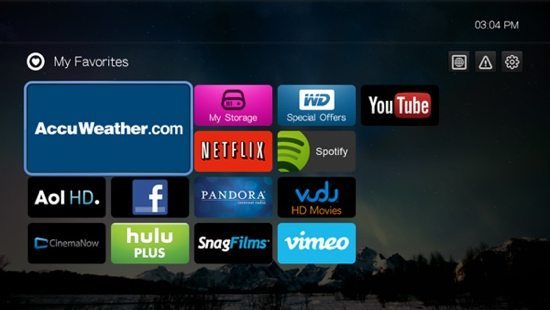
The Play includes HDMI output in addition to composite AV (which is handy if you have an older TV), as well as optical digital audio (just like the Apple TV) and an Ethernet port – though it does of course support wireless connectivity too. And like the Roku, it also includes a USB port so you can hook up an external hard drive or memory stick.
The remote control isn’t as elegant as the Apple TV one, but has a few preset navigation keys for Netflix, Vudu and Hulu Plus (though you can change their configuration to launch other channels). And just like Apple TV’s Remote app, there’s also a WDTV Remote application for both iOS and Android devices.
Unfortunately, the WDTV Play doesn’t have nearly as many channels as the Roku box, but does have all the most popular ones such as Netflix, Hulu Plus, Spotify, Pandora and Vudu, as well as the ability to display your photos from online sites such as Flickr and Picasa, in addition to YouTube videos. There’s Facebook integration so you can comment and share what you’re watching, but it doesn’t really add much to the overall experience.
Perhaps the best thing about the Play is it’s ability to play local content from an external device, as it supports a very wide selection of multimedia formats. All in all, the WDTV Play is the best value for money, especially if you need multiple boxes to hook up around the home, or already have an Apple TV and just want an extra device with different capabilities.
Pros:
- Supports a very wide variety of multimedia formats (e.g. AVI, MKV, MP4, FLV, and WMV9)
- Very affordable – one of the cheapest on the market
- Channels include popular streaming services like Netflix and Spotify
- There’s a handy remote control app available for iOS
Cons:
- The UI is sometimes rather sluggish and unresponsive
- There’s no way to add additional channels (except for firmware updates)
Google TV![]()
Price: various
There’s been a lot of hoo-ha about Google TV lately – but what is it and is it actually any good? Google doesn’t make the hardware itself – that’s left to a handful of manufacturers such as Sony (with the NSZ-GS7) and Asus (the Google TV Qube). This means you have a choice of set-top boxes with varying capabilities and price-points. Google refers to these devices as “buddy boxes”, and there’s a full list available here (though the list is actually very small – presumably more will be available over time).
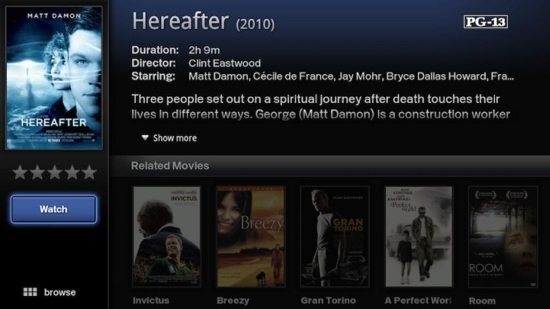
Regardless of the hardware you opt for, Google TV features a wide selection of movie and video channels. There are also dozens of music apps including Google Music and Pandora, so you can stream virtually unlimited music over the Internet. And because Google TV runs the Android OS, there are thousands of apps and games available via the Google Play online store, making it rather more flexible than the Apple TV and perhaps a good choice for those that want to do more than just watching movies.
There’s also an Android app called Airtight which will let you use AirPlay with Google TV devices.
Asus Google TV Qube
Price: $129
Dealing with the Qube first (which seems to be only available in the US currently at around $140), it’s rather cheap-looking and plasticky (and quite large, at least compared to the Apple TV), but differentiates itself by having a built-in mic (on the remote) for voice searching, as well as a rather interesting (albeit slightly confusing) cube-like interface to browse content and navigate. The cube spins up or down to move between categories (TV and movies, gaming, social, sports, music, news, education, photos, and favourites).
Unsurprisingly, the Qube connects to your TV via a HDMI cable, but also provides 2 USB ports to connect to external media. Perhaps it’s best feature however is the funky double-sided remote, which has a mini QWERTY keyboard one one side and a trackpad on the other, and and built-in gyroscope which is great for playing Android games. Asus also provides 50GB of cloud storage (in addition to it’s internal 4GB of storage).
Perhaps the biggest surprise is that AirPlay is already built into the Asus Qube, so you can watch most of your existing content from your Apple devices. Users have reported however that it only works with video content such as YouTube, and doesn’t work with your music library or pictures – and we’re not sure whether it works on the Mac too or just iOS devices. Still, it’s quite exciting that AirPlay is supported at all.
Overall, the Asus is a pretty decent attempt at a Google TV device that won’t break the bank, but at the time of writing there’s no word on a UK release date or price. For Apple Mac and iOS users, there’s probably not enough here to tempt you away from an Apple TV, but for everyone else it’s definitely worth of consideration.
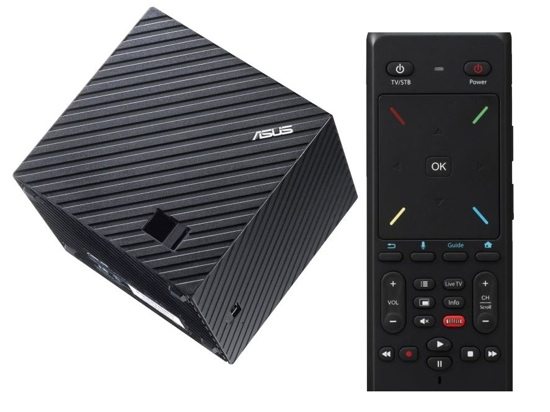
Pros:
- Good choice of content through Google TV and Google Play
- Comes with AirPlay (albeit limited in functionality) out of the box!
- Decent remote control with gaming features
- Slightly cheaper than Apple TV
Cons:
- Fairly cheap-looking and not quite as small as an Apple TV or Roku
- Even though the cube UI is innovative, it might put some people off
Sony NSZ-GS7
Price: around £100 (Amazon UK)
Sony’s NSZ-GS7 is a fully functional Google TV buddy box and media hub. It certainly looks the part being black, glossy and quite cool-looking. There’s an HDMI input to connect to your cable/satellite system and an output to the TV, plus two USB ports, an optical audio output, Ethernet (and built-in WiFi).
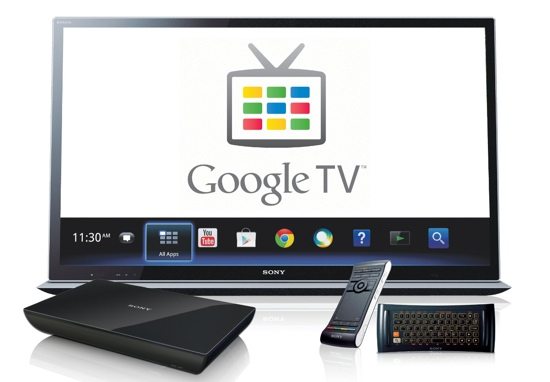
The remote control is easy to use, with one side containing a touchpad normal remote control buttons and the other a QWERTY keyboard. There are various TV controls, playback controls and coloured buttons below.
The Sony machine has the same Google TV interface as other systems, which is based on Android. This means it can access Google Play and thousands of apps, however not all Android apps work fully with Google TV (although admittedly Google TV-friendly apps are highlighted in the store). The problem (as with all Android devices) is that there’s a massive selection of dross that you have to search through to get to the decent content. It can be a worthwhile task, but some people might quickly get bored trying to find something they actually find useful.
For online content the NSZ-GS7 has a very wide variety of selection such as the mainstays Netflix and YouTube, as well as Google Play’s music service and movies, in addition to Sony’s own service including Music Unlimited and Video Unlimited libraries.
Furthermore, the Sony box can be found online for as little as £100, which puts it firmly in the same price bracket as the Apple TV.
Pros:
- Includes a very effective remote control
- Lots of features and functionality
- Plenty of online services and applications
- High quality construction and reliable brand
Cons:
- Not as slick as comparable devices
- Not easy to find good Android apps
Which Internet TV is Best?
We’ve covered just a few of the current crop of Apple TV alternatives, but there are sure to be more released in the coming year. Each device offers something slightly different, but it really comes down to a choice between Apple TV, Google TV, and a couple of other systems such as Roku.
Overall, the Roku is probably the best alternative right now to the Apple TV, mainly due to its great content selection and also the ability to use AirPlay via a third-party app. If you already use a Mac and iOS devices however and have an existing iTunes library that you watch more than other local content, there’s no denying that the Apple TV, while not having the most features, is certainly the easiest and most convenient Internet TV system available.


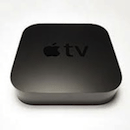


Add Comment